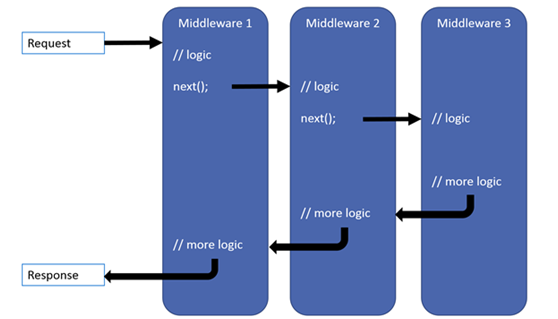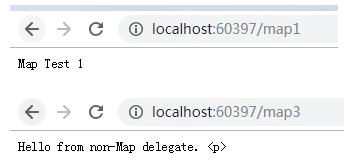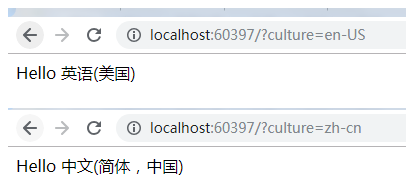asp.net core 系列 15 中间件
一.概述
中间件(也叫中间件组件)是一种装配到应用管道以处理请求和响应的软件。 每个组件:(1)选择是否将请求传递到管道中的下一个组件;(2)可以在管道中的下一个组件之前和之后执行工作。
请求委托用于生成请求管道。 请求委托会处理每个 HTTP 请求。使用以下方法配置请求委托:Run, Map, Use扩展方法。可以将单个请求委托作为匿名方法(称为内联中间件in-line middleware) 或者可以在可重用类中定义。这些可重用的类和内联匿名方法是中间件,也称为中间件组件。请求管道中的每个中间件组件负责调用管道中的下一个组件,或使管道短路。
(1) Run
//将终端中间件委托添加到应用程序的请求管道中。
public static class RunExtensions
{
public static void Run(this IApplicationBuilder app, RequestDelegate handler);
}
(2) Map
// 根据给定请求路径的匹配对请求管道进行分支。
public static class MapExtensions
{
public static IApplicationBuilder Map(this IApplicationBuilder app, PathString pathMatch, Action<IApplicationBuilder> configuration);
}
(3) Use
// 提供配置应用程序请求的机制
public interface IApplicationBuilder
{
//....
// 将中间件委托添加到应用程序的请求管道中。
IApplicationBuilder Use(Func<RequestDelegate, RequestDelegate> middleware);
}
1.1 使用 IApplicationBuilder 创建中间件管道
在Startup. Configure方法中,使用IApplicationBuilder来创建中间件管理。每一个use开头的扩展方法将一个中间件添加到IApplicationBuilder请求管道中。使用Use扩展方法来配置请求委托。每个use的中间件类似如下声明:
public static IApplicationBuilder Use[Middleware] (this IApplicationBuilder app ) public static IApplicationBuilder Use[Middleware] (this IApplicationBuilder app , Action<T>)
ASP.NET Core 请求管道包含一系列请求委托,依次调用。 下图演示了这一概念。 沿黑色箭头执行。

在Startup. Configure代码中,一系列use请求委托中间件如下所示:
app.UseHttpsRedirection(); app.UseStaticFiles(); app.UseCookiePolicy(); app.UseMvc();
委托可以决定不将请求传递给下一个委托(中间件),这就是对请求管道进行短路。通常需要短路,因为这样可以避免不必要的工作。
下面示例 是一个最简单的 ASP.NET core 应用程序,用run方法配置请求委托,设置单个委托处理处理所有请求。此案例不包括实际的请求管道。相反,调用单个匿名函数以响应每个 HTTP 请求。并用委托终止了管道。
public class Startup
{
public void Configure(IApplicationBuilder app)
{
app.Run(async context =>
{
await context.Response.WriteAsync("Hello, World!");
});
}
}

下面示例用Use方法将多个请求委托链接在一起,
next参数表示管道中的下一个委托。 可通过不调用 next 参数使管道短路。
app.Use(async (context, next) =>
{
//调用下一个委托(app.run)
await next.Invoke();
});
app.Run(async context =>
{
await context.Response.WriteAsync("Hello, World!");
});
1.2 中间件顺序
向
Startup.Configure方法添加中间件组件的顺序定义了针对请求调用这些组件的顺序,以及响应的相反顺序。 此排序对于安全性、性能和功能至关重要。以下
Startup.Configure方法将为常见应用方案添加中间件组件:
(1) 异常/错误处理
(2) HTTP 严格传输安全协议
(3) HTTPS 重定向
(4) 静态文件服务器
(5) Cookie 策略实施
(6) 身份验证
(7) 会话
(8) MVC
public void Configure(IApplicationBuilder app)
{
if (env.IsDevelopment())
{
// When the app runs in the Development environment:
// Use the Developer Exception Page to report app runtime errors.
// Use the Database Error Page to report database runtime errors.
app.UseDeveloperExceptionPage();
app.UseDatabaseErrorPage();
}
else
{
// When the app doesn't run in the Development environment:
// Enable the Exception Handler Middleware to catch exceptions
// thrown in the following middlewares.
// Use the HTTP Strict Transport Security Protocol (HSTS)
// Middleware.
app.UseExceptionHandler("/Error");
app.UseHsts();
}
// Use HTTPS Redirection Middleware to redirect HTTP requests to HTTPS.
app.UseHttpsRedirection();
// Return static files and end the pipeline.
app.UseStaticFiles();
// Use Cookie Policy Middleware to conform to EU General Data
// Protection Regulation (GDPR) regulations.
app.UseCookiePolicy();
// Authenticate before the user accesses secure resources.
app.UseAuthentication();
// If the app uses session state, call Session Middleware after Cookie
// Policy Middleware and before MVC Middleware.
app.UseSession();
// Add MVC to the request pipeline.
app.UseMvc();
}
(1) UseExceptionHandler 是添加到管道的第一个中间件组件。 该异常处理程序中间件可捕获稍后调用中发生的任何异常。
(2) UseStaticFiles 静态文件中间件,应该在管道的早期调用。这样它就可以处理请求和短路,而不需要遍历其余组件。静态文件中间件不提供授权检查。 它提供的任何文件,包括wwwroot下的文件,都是公开可访问的。
(3) UseAuthentication 身份验证中间件。未经身份验证的请求不会短路,但只有在特定的Razor页面或MVC控制器操作之后,才会发生授权(和拒绝)。
1.3 Use、Run 和 Map
配置 HTTP 管道可以使用Use、Run 和 Map,但各方法针对构建的中间件作用不同:
(1) Use[Middleware]中间件负责调用管道中的下一个中间件,也可使管道短路(即不调用
next请求委托)。
(2) Run[Middleware]是一种约定,一些中间件组件可能会公开在管道末端运行的Run[Middleware]方法。
(3) Map扩展用作约定来创建管道分支, Map*创建请求管道分支是基于给定请求路径的匹配项。
public void Configure(IApplicationBuilder app, IHostingEnvironment env)
{
app.Map("/Map1",HandleMapTest1);
app.Map("/Map2", HandleMapTest2);
//其它请求地址
app.Run(async context =>
{
await context.Response.WriteAsync("Hello from non-Map delegate. <p>");
});
}
private static void HandleMapTest1(IApplicationBuilder app)
{
app.Run(async context =>
{
await context.Response.WriteAsync("Map Test 1");
});
}
private static void HandleMapTest2(IApplicationBuilder app)
{
app.Run(async context =>
{
await context.Response.WriteAsync("Map Test 2");
});
}

Map 还支持嵌套,下面的示例中,请求访问/level1/level2a 和 /level1/level2b时进行不同逻辑处理:
app.Map("/level1", level1App => {
level1App.Map("/level2a", level2AApp => {
// "/level1/level2a" processing
});
level1App.Map("/level2b", level2BApp => {
// "/level1/level2b" processing
});
});
1.4 MapWhen
MapWhen 基于url给定谓词的结果创建请求管道分支。 Func<HttpContext, bool> 类型的任何谓词均可用于将请求映射到管道的新分支。 在以下示例中,谓词用于检测查询字符串变量 branch 是否存在,如果存在使用新分支(HandleBranch)。
public void Configure(IApplicationBuilder app, IHostingEnvironment env)
{
//Func<HttpContext, bool> predicate, Action<IApplicationBuilder> configuration
app.MapWhen(context => context.Request.Query.ContainsKey("branch"), HandleBranch);
//非匹配branch其它请求地址
app.Run(async context =>
{
await context.Response.WriteAsync("Hello from non-Map delegate. <p>");
});
}
private static void HandleBranch(IApplicationBuilder app)
{
app.Run(async context =>
{
var branchVer = context.Request.Query["branch"];
await context.Response.WriteAsync("Map Test 1");
});
}

二. 编写中间件
上面演示在请求管道中使用use,map,run方法,来委托处理每个 HTTP 请求就是中间件。通常中间件会封装在类中,并且通过扩展方法公开。下面示例是如何编写一个中间件组件。处理逻辑是该中间件通过查询字符串设置当前请求的区域性。
/// <summary>
/// 自定义中间件实现类
/// </summary>
public class RequestCultureMiddleware
{
//using Microsoft.AspNetCore.Http
private readonly RequestDelegate _next;
/// <summary>/// 程序启动时调用
/// </summary>
/// <param name="next"></param>
public RequestCultureMiddleware(RequestDelegate next)
{
this._next = next;
}
/// <summary>///每个页面请求时自动调用,方法按约定命名,必需是Invoke或InvokeAsync
/// </summary>
/// <param name="context"></param>
/// <returns></returns>
public async Task InvokeAsync(HttpContext context)
{
var cultureQuery = context.Request.Query["culture"];
if (!string.IsNullOrWhiteSpace(cultureQuery))
{
//using System.Globalization;
var culture = new CultureInfo(cultureQuery);
CultureInfo.CurrentCulture = culture;
CultureInfo.CurrentUICulture = culture;
}
// Call the next delegate/middleware in the pipeline
await _next(context);
}
}
/// <summary>
/// 通过扩展方法公开中间件
/// </summary>
public static class RequestCultureMiddlewareExtensions
{
public static IApplicationBuilder UseRequestCulture(this IApplicationBuilder builder)
{
//在管道中添加一个use的中间件
return builder.UseMiddleware<RequestCultureMiddleware>();
}
}
public void Configure(IApplicationBuilder app)
{
//调用中间件
app.UseRequestCulture();
app.Run(async (context) =>
{
await ResponseAsync(context);
});
}
private async Task ResponseAsync(HttpContext context)
{
context.Response.ContentType = "text/html; charset=utf-8";
await context.Response.WriteAsync(
//打印当前显示的语言
$"Hello { CultureInfo.CurrentCulture.DisplayName }"
);
}

2.1 请求依赖项
由于中间件是在应用启动时构造的(实例),而不是在每个请求时的,因此在每个请求过程中,中间件构造函数使用的作用域生命周期服务,不会在每个请求期间与其他依赖注入类型共享。如果必须在中间件和其他类型之间共享一个范围服务,请将这些服务添加到
Invoke方法的签名。
Invoke方法可接受由 DI 填充的参数:
public class CustomMiddleware
{
private readonly RequestDelegate _next;
public CustomMiddleware(RequestDelegate next)
{
_next = next;
}
// IMyScopedService is injected into Invoke
public async Task Invoke(HttpContext httpContext, IMyScopedService svc)
{
svc.MyProperty = 1000;
await _next(httpContext);
}
}
参考文献:
官方文档:ASP.NET Core 中间件
- Asp.Net.Core 系列-中间件和依赖注入基础篇
- Asp.Net.Core 系列-中间件和依赖注入进阶篇
- ASP.NET Core 2.0系列学习笔记-Middleware中间件
- Asp.Net.Core 系列-中间件和依赖注入Hosting篇
- 剖析ASP.NET Core(Part 4)- 调用MVC中间件(译)
- 2.5配置的框架浅析「深入浅出ASP.NET Core系列」
- 1.5准备CentOS和Nginx环境「深入浅出ASP.NET Core系列」
- 5.2基于JWT的令牌生成和定制「深入浅出ASP.NET Core系列」
- asp.net core 系列 4 注入服务的生存期
- 学习ASP.NET Core Razor 编程系列三——创建数据表及创建项目基本页面
- asp.net core 系列 12 选项 TOptions
- ASP.NET Core 2.0系列学习笔记-NLog日志配置文件
- 15:ASP.NET复习系列- ASP.NET提高- ASP.NET实现在服务器端控制网页
- 浅谈ASP.NET Core 中间件详解及项目实战
- asp.net core 中间件详解及项目实战
- 深入浅出ASP.NET Core系列(入门篇)
- 4.2WebHost配置「深入浅出ASP.NET Core系列」
- 微服务介绍及Asp.net Core实战项目系列之微服务介绍
- ASP.NET Core 2.2 基础知识(四) URL重写中间件
- asp.net core 系列 4 路由(上)
